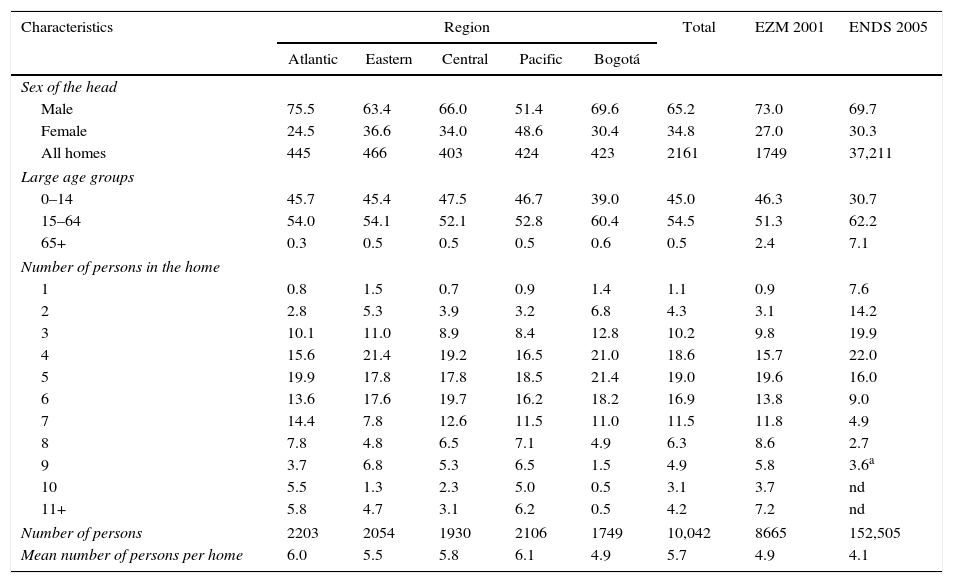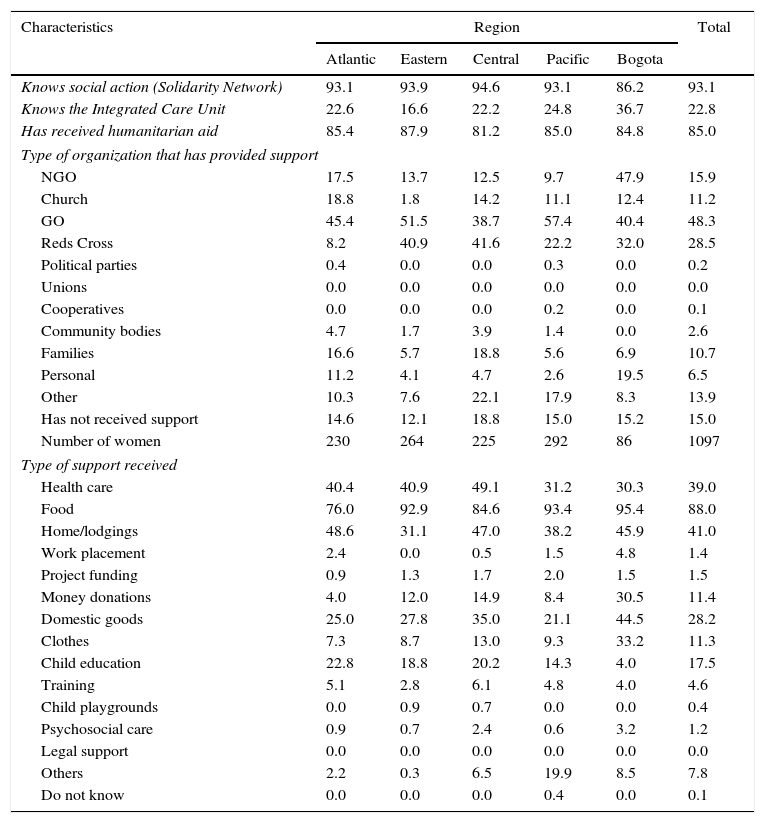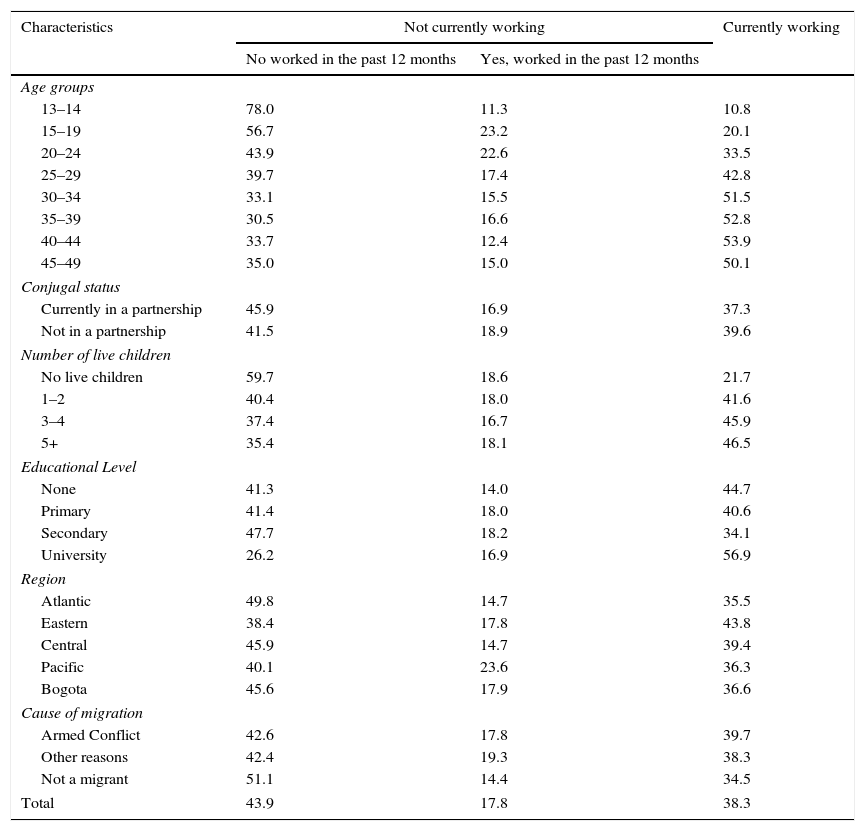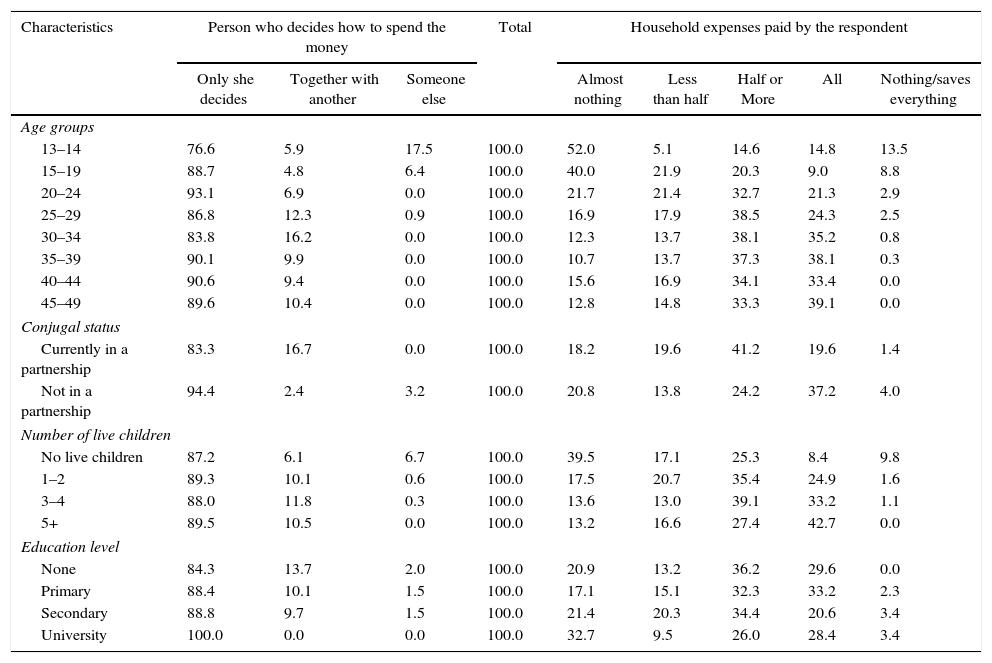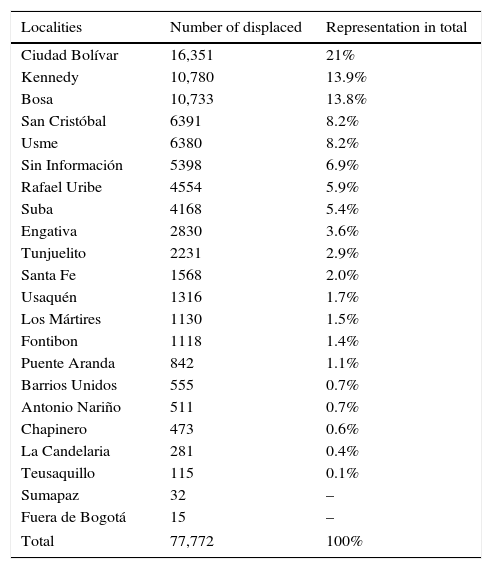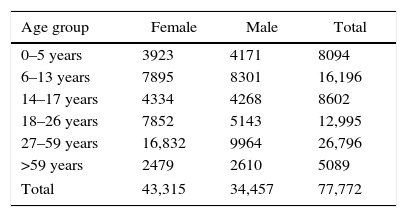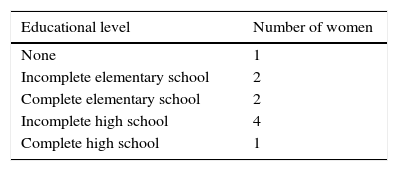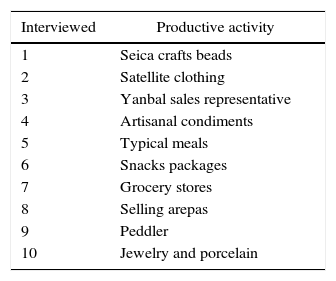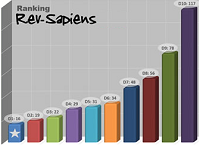This article identifies the characteristics of internally displaced women’ entrepreneurships. It was made a literature review about the principal categories and a semi structured interview with ten internally displaced women in Usme – Bogotá. The exposure to violent episodes conditions the internally displaced women’ entrepreneurship processes, making them different from the entrepreneurships of women in other social contexts.
Este artículo identifica las características de las capacidades empresariales de mujeres en situación de desplazamiento. Se realizó una revisión bibliográfica de las categorías principales y se aplicó una entrevista semiestructurada a 10 mujeres de la localidad de Usme en Bogotá. La exposición a episodios violentos, específicamente el desplazamiento interno, condiciona los procesos emprendedores de las mujeres y los convierte en notoriamente diferentes a las capacidades empresariales de mujeres en otros contextos sociales.
According to Martha Lamas (2000, p. 2) gender is “a set of ideas, performances, practices and social prescriptions that a culture develops from the anatomical difference between women and men, to symbolize and socially build what is “own” of the men (masculine) and “own” of the women (feminine)”.
The symbolism built translates into differences in the conception of what men and women should do. A clear case of this segmentation is entrepreneurial activity; women who start such activity usually face negative attitudes, on one side of their male counterparts who consider them incapable to successfully manage a business, and secondly other women considering that these activities break the roles assigned to women (Kargwell, 2012, p. 1). The perception of the women as mother and wife proportioning care affects the propensity of women to undertake and develop activities outside their homes.
The vulnerable situation of women entrepreneurs is accentuated when dragging a past of violence and entrepreneurship does not arise as a result of influences and a successful business past, as described by Jia, Parvin, and Rahman (2012), but of adverse environmental factors to address the lack of opportunities to join the formal sector leaves them as the only alternative of subsistence self-employment.
Evidence of this is described by Ibañez and Moya (2010) who found that domestic abuse rates are higher in households where women in situations of displacement, in the presence of her husband, are the heads of household. This is because men by not fulfilling their role as facilitators of food are relegated and use the mistreatment as a mechanism for ratification of its command and control within the family structure.
This article makes an initial approach to the life stories and the characterizations of undertakings of ten women victims of forced displacement in Colombia. To that end, this article is divided into five sections, the first is a description of the methodology used, in the second an empirical review of the situation of women victims of forced displacement is done, in the third the theoretical background of female entrepreneurship is review, the fourth presents a statistical description of the displaced population, then the results of the qualitative study are presented and finally concluding remarks in the light of the findings are made.
MethodologyThe characterization of female entrepreneurship in displacement in Usme locality was done in two stages. In the first, was made a statistical review of the displaced population in Bogota from the data of the Secretariat of Government of the Capital District.
In the second stage, a semi-structured interview was applied to 10 women entrepreneurs in Usme locality in 2012. The selection of Usme locality it was done for two reasons: The first is that this locality is the fifth with the largest number of displaced population (8%); the second reason is the possibility of access to the population, which is justified by the work as a rectory secretariat of this research practitioner, Claudia Reynel, in the District Educational Institution Eduardo Umaña Mendoza of the locality.
The instrument used for data collection was divided into three categories taking as reference the factors that influence entrepreneurship, cited by Jia et al. (2012). Firstly it was investigated by the history of displacement suffered by women entrepreneurs to understand the impact of the above influences and the importance of previous work experience in the creation of their entrepreneurship. Secondly information about their socioeconomic conditions was collected to analyze the environmental factors that influenced the decision to undertake. Finally, thirdly we sought to know the stories of entrepreneurship and its particular characteristics.
Conditions of women in situations of displacement“War is a social activity. Wrap the mobilization and organization of men, for the purpose of inflicting physical violence, involves regulation of certain types of social relations and has its own particular logic” (Kaldor, 2001, p. 13)
The Colombian armed conflict became the engine of the national economy. The generation of wealth in the country is from the coexistence of economies of international aid, criminal economy (led by criminal actors engaged in activities ranging from drug trafficking to monopolistic trade practices), informal economy and the remaining formal economy (Kamphuis, 2005, p. 186).
In addition to the economic implications of the armed conflict it has permeated all instances of Colombian society to the point that the country revolves around war and its consequences for the entire population. One of the most dramatic problems is the forced displacement that Law 387 of 1997 in its article 1 defines as: Anyone who has been forced to migrate within the national territory, abandoning his place of residence or habitual economic activities because their live, physical integrity, safety or personal freedom have been violated or are directly threatened, during any of the following situations: internal armed conflict, internal disturbances and tensions, generalized violence, massive human rights violations, breaches of international humanitarian law or other circumstances originating from prior situations that can dramatically alter or disturb public order
In Colombia according to the Consultancy for Human Rights and Displacement – CODHES between 1980 and 2010 It occurred the dispossession of 6,638,195ha by violent actions of illegal armed groups. In 2010, 280,041 people were forcibly displaced who arrived to 1014 municipalities of the country, that for an average of 778 displaced people in the country every day (CODHES, 2011, p. 8).
Another source, the United Nations High Commissioner for Refugees – UNHCR – says that in Colombia are registered 3.2 million of displaced people, of which about 83% are women and children. For 2008, 43% of families in this situation have a woman as head of household, and 68 of 100 cases, these women are alone (UNHCR, 2009).
CODHES estimates that in the 1985–2010 period 5,195,620 persons (1,039,124 households) were displaced in Colombia because of violence, equivalent to 11.42% of the country population. In addition, government policy toward the conflict in the period 2002–2010 generated underreporting's and created garments of doubt about the nature of the problem of displacement in the country (CODHES, 2011, p. 9).
As evidence of the difficulty in the identification of the displaced population in the country. Fig. 1 shows how the difference between the number of people displaced between the program of the Presidency of the Republic Social Action and CODHES sometimes differ by more of 150,000 individuals per year.
Number of displaced people in Colombia from 1997 to 2010. Source: CODHES (2011, p. 9).
Also, CODHES evidence as the trend of forced displacement is positive for the period 1999–2010. The data show a steady upward trend of the population is forced to leave their homes with peaks in 2002 in which 400,000 people were displaced and 2008 in which 370,000 people fled their homes forcibly (CODHES, 2011, p. 9) (see Fig. 2).
Trend of forced displacement in Colombia (1999–2010). Source: CODHES (2011, p. 9).
Displacement has differential effects on men and women, according to UNHCR (2010), the particular effects from the gender perspective can be seen in:
- •
The restriction on the amount and the type of food the women eat for their role of trainers and food distributors.
- •
Work overload due to the impossibility of men to assume their tasks of providing regular and low involvement with the housework.
- •
Rupture of support networks and links with the place of origin because they cannot socialize in the common spaces.
- •
Arbitrary transformation of traditions by the abrupt insertion into a different society.
According to the Committee for the Elimination of All Forms of Discrimination against Women (CEDAW) the effects of internal displacement in women are strong, there are thousands who lack of resources for their sustenance, in a scenario in which they must “assume more responsibilities both reproductive and productive, toward their families and communities” (Edwards, 2009, p. 6) in 2001, 31 of every 100 displaced families had a woman as head of household (CODHES, 2001).
Workbench: claims that forced displacement: It affects family structures (increases of rural households headed by women), community (dismantles organizational processes of displaced communities), social and cultural (facing displaced families with unknown environments for them); and leaves families unable to meet their basic needs autonomously […] (Workbench: Women and Armed Conflict, 2000, p. 6.)
But families are not the only social structures that are seen disintegrated with the conflict, many leaders of women's organizations are murdered or threatened to abandon their social and political activities. The armed groups found in the leadership exercised by women an obstacle to the progress of the territorial control of armed groups.
Workbench (2001) shows examples of two organizations in their role as entrepreneur's agents in a population suffered harassment and threats from armed groups. The first one is the Popular Women's Organization (OFP), this group operates in Barrancabermeja – Santander, and emphasizes its work in humanitarian aid to displaced families, food assistance and training in production processes and human rights for women members; however, they were declared military targets by the paramilitaries and suffered various attacks on his headquarters in the southern sector – east of the city, even though they requested security to the competent authorities the attacks remained even in daylight without the intervention of the public force.
The next case is the National Association of Peasant and Indigenous Women of Colombia ANMUCIC. The organization works in 27 departments of the country and focuses on the sponsorship of economic and social projects, provide human rights training health and agrarian reform, and in the learning to manage conflict. The association has suffered serious attacks against their officials, and in departments such as Cordoba, Valle and Norte de Santander has had to suspend their activities. Three departmental leaders of the organization were killed and one of them had to leave their place of residence by the threats of paramilitary groups linked to the FARC guerrillas.
According to the Report of the High Commissioner of the United Nations Human Rights on the situation of human rights in Colombia, quoted by Workbench (2001, p. 16): Women in Colombia represent 54% of the poor population and 25% of households are headed by women. Women are located in the more traditional fronts of the productive apparatus and constitute about 60% of the informal sector of the economy, representing long working hours, job insecurity and exclusion from the social security system. Plus they still located in the lower and middle levels of the occupational categories.
Ibañez and Moya (2010) state that in addition to the emotional costs, forced displacement imposes high economic costs to the victims in at least three ways: First, the loss of assets weakened the sources of income of displaced households. Second, the returns of human capital are reduced because the displaced persons have experience particularly in agricultural activities that are not properly valued in cities. And thirdly, access to financial capital and hedge against the risk of households is limited resulting in greater vulnerability to future events and pushes the population to poverty traps that are difficult to overcome.
However, the processes of adaptation of men and women to the new conditions imposed by the displacement are heterogeneous. Authors such as Meertens and Stoller (2001) suggest that while the skills of women are more akin to the demands of urban labor markets, the agricultural experience of men is hardly valued. Likewise, the entry of women into the labor market may strengthen their bargaining power within the household and decrease gender discrimination.
Calderon, Gafaro and Ibanez (2011, p. 14) found that women in situations of displacement in Colombia work 8h per week than women in the countryside and their wage rates are 1.8 times higher. In contrast, the displaced men are worse off than those who remain in the countryside, with a fall of 8.2% in the participation rate. The study also shows that the contribution of women to household income increases by 14% after displacement.
Despite the increase in labor participation of women, the authors found that their bargaining power is not increased compared to the rural population. While 29.5% of women take more than half of the costs, only 9.7% has the final say in the decision to consumption areas such as health, food, durable goods, etc. In the case of rural women 15.4% assumes half of the expenses and 7.8% has the last word in deciding consumption. The difference between rural and displaced women is not statistically significant which shows that the bargaining power of Colombian women in situations of displacement is not affected by the increase in their incomes or displaced.
Women's entrepreneurshipAccording to Castiblanco (2013) studies on female entrepreneurship in the world, from the 1990s, have focused on four key elements for its understanding. The first group seeks to identify the sociodemographic characteristics such as age, education, previous work experience, marital status, number of children, among others, of women who decide to carry out entrepreneurship. In this group, the works of Kargwell (2012), Cuevas and Rodríguez (2008) and Franck (2012) are highlighted. These studies find that women entrepreneurs are characterized as being young, with higher levels of secondary education and have previous work experience.
Second, the studies are about the differences between men and women entrepreneurship, in which are essential the contributions of Jia et al. (2012) and Kabeisi (2010). These studies identified that the activities of women entrepreneurs mostly belong to the trade sector (47%), manufacturing (20%) and services (17%). The author argues that differences in the type of business are attributable to cultural barriers; women tend to work in home related because they are socially more acceptable activities. Also some businesses are not accessible due to their training, which is evident in technology-related businesses. While men focus on more related to math and science areas, women do in the areas related to the humanities. Therefore, women are less likely than men to be found in engineering or science; they usually do not have the science education that would help them start businesses requiring technical skills.
Additional differences between female entrepreneurs and male entrepreneurs can be found in the motivations for starting their businesses and in their reaction to risk. The women indicated that their main motivation to start their business is to generate income and spend their free time. Moreover, the men said that while seeking to increase their revenue, their priority is to gain financial independence (Kargwell, 2012, p. 2).
Regarding risk perception, the information gathered shows that women are more sensitive to risk than men. For women is more important access to a stable potential market than higher profits with higher risk, which leads them to prefer businesses with less chance of failure than those preferred by men. Only 30.2% of women would accept work in high-risk activities in counterpart with men, they would in 50.9% (Kargwell, 2012, p. 2).
Third, works as Hanson (2009), Nigthingale (2006) and Leung (2011), seeks to understand how the context can affect the decision to start a productive activity and how the cultural construction of gender plays a major role in this decision. Here it should be noted that factors more related to women entrepreneurship are: freedom to work, the desire for higher income, the desire to achieve greater social status, higher educational levels, family size, family relationships, death of the husband or head of household, the motivation of relatives and/or friends, access to credit, access to training in entrepreneurship, government aid, membership in associations of entrepreneurs, access to business information and favorable to entrepreneurship infrastructure. Hanson (2009) found that women entrepreneurs generate changes in at least four ways: (1) simply by starting a business are in contravention of the ideologies about gender and thus altering previous ideas about the same; (2) women measure the success of their businesses as a proportion of welfare provided to the community, creating hybrid organizations, including organizations for profit and non-profit; (3) established women entrepreneurs play an important role by being mentors for others and helping more female entrepreneurs to emerge in the community, increasing the density of women business owners in a locality and changing the structures of local institutions; and (4) women use their enterprises as a way of voluntary activities in their communities, such as getting children in their stores after-school, not tolerating sexually abusive behavior in their communities or initiating education activities for women and children.
Selection and characteristics of the populationThe National Survey of Displaced Persons (END) 2005 by Profamilia between 2001 and 2005 conducted in 120 municipalities with more than 100 people displaced presents the best diagnosis of the problem of displacement in the country.
The END showed that in a country level 65.2% of homes are in a displaced situation the household heads are men, a relationship that is replicated in Bogota where men head 69.6% of households. Likewise, displaced persons are located mainly in the age group of 15–64 years, and live mostly with four other people in their homes (see Table 1).
National Survey of Displaced Persons (END) 2005.
| Characteristics | Region | Total | EZM 2001 | ENDS 2005 | ||||
|---|---|---|---|---|---|---|---|---|
| Atlantic | Eastern | Central | Pacific | Bogotá | ||||
| Sex of the head | ||||||||
| Male | 75.5 | 63.4 | 66.0 | 51.4 | 69.6 | 65.2 | 73.0 | 69.7 |
| Female | 24.5 | 36.6 | 34.0 | 48.6 | 30.4 | 34.8 | 27.0 | 30.3 |
| All homes | 445 | 466 | 403 | 424 | 423 | 2161 | 1749 | 37,211 |
| Large age groups | ||||||||
| 0–14 | 45.7 | 45.4 | 47.5 | 46.7 | 39.0 | 45.0 | 46.3 | 30.7 |
| 15–64 | 54.0 | 54.1 | 52.1 | 52.8 | 60.4 | 54.5 | 51.3 | 62.2 |
| 65+ | 0.3 | 0.5 | 0.5 | 0.5 | 0.6 | 0.5 | 2.4 | 7.1 |
| Number of persons in the home | ||||||||
| 1 | 0.8 | 1.5 | 0.7 | 0.9 | 1.4 | 1.1 | 0.9 | 7.6 |
| 2 | 2.8 | 5.3 | 3.9 | 3.2 | 6.8 | 4.3 | 3.1 | 14.2 |
| 3 | 10.1 | 11.0 | 8.9 | 8.4 | 12.8 | 10.2 | 9.8 | 19.9 |
| 4 | 15.6 | 21.4 | 19.2 | 16.5 | 21.0 | 18.6 | 15.7 | 22.0 |
| 5 | 19.9 | 17.8 | 17.8 | 18.5 | 21.4 | 19.0 | 19.6 | 16.0 |
| 6 | 13.6 | 17.6 | 19.7 | 16.2 | 18.2 | 16.9 | 13.8 | 9.0 |
| 7 | 14.4 | 7.8 | 12.6 | 11.5 | 11.0 | 11.5 | 11.8 | 4.9 |
| 8 | 7.8 | 4.8 | 6.5 | 7.1 | 4.9 | 6.3 | 8.6 | 2.7 |
| 9 | 3.7 | 6.8 | 5.3 | 6.5 | 1.5 | 4.9 | 5.8 | 3.6a |
| 10 | 5.5 | 1.3 | 2.3 | 5.0 | 0.5 | 3.1 | 3.7 | nd |
| 11+ | 5.8 | 4.7 | 3.1 | 6.2 | 0.5 | 4.2 | 7.2 | nd |
| Number of persons | 2203 | 2054 | 1930 | 2106 | 1749 | 10,042 | 8665 | 152,505 |
| Mean number of persons per home | 6.0 | 5.5 | 5.8 | 6.1 | 4.9 | 5.7 | 4.9 | 4.1 |
However a more specific breakdown of the age groups of the population in displacement situation shows that the largest group is children between 5 and 9 years with a share of 16.7% followed by children between 0 and 4 years old accounted for 15.9% of the population. The segments with a higher proportion of women in situations of displacement are girls between 10 and 14 years (14%) aged between 5 and 9 years (13.9%) (Profamilia, 2005, p. 32).
As for the living conditions of the displaced persons it is highlighted that the provision of public services, often cited as the main feature in the selection of Bogota as a destination, not far exceeds other regions. However, ownership of consumer goods it has higher averages in Bogota partially confirming the hypothesis of offer greater opportunities for income generation in this city (Profamilia, 2005, p. 30).
Education levels of people displaced allow see reductions in gender gaps qualification. At all levels of education, except university, the proportion of women is higher than men (see Table 2).
Education levels of people displaced.
| Gender | None | Primary | Secondary | University | Average years of education |
|---|---|---|---|---|---|
| Male | 14.6 | 56.0 | 28.0 | 1.2 | 4.1 |
| Female | 13.0 | 54.6 | 31.2 | 1.1 | 4.4 |
Source: PROFAMILIA (2005, p. 32).
The END also inquired about the reasons for displacement of the women mentioned as the two main reasons the threat to the security of the family (53.6%) and the “order” of armed groups to abandon the land (21.7%). Other reasons cited were murder of family members (8.7%), threats to personal security (7.0%), massacres (4.4%) and murder of her husband (2.6%) (Profamilia, 2005, p. 37).
The schemes of helping women in situations of displacement have focused on emergency aid, that is, subsidies for housing, food, health and household goods. However, aids to finance productive projects do not exceed 2%. It also highlights the main organizations providing aid in Bogota are nongovernmental organizations (NGOs) (47.9%) organizations followed by NGOs (40.4%) in the rest of the country NGOs contribute on average 15.9% of aid NGOs and 48.3% (see Table 3) (Profamilia, 2005, p. 42).
Proportion of women displaced by internal conflict and its relationship with the major aid agencies.
| Characteristics | Region | Total | ||||
|---|---|---|---|---|---|---|
| Atlantic | Eastern | Central | Pacific | Bogota | ||
| Knows social action (Solidarity Network) | 93.1 | 93.9 | 94.6 | 93.1 | 86.2 | 93.1 |
| Knows the Integrated Care Unit | 22.6 | 16.6 | 22.2 | 24.8 | 36.7 | 22.8 |
| Has received humanitarian aid | 85.4 | 87.9 | 81.2 | 85.0 | 84.8 | 85.0 |
| Type of organization that has provided support | ||||||
| NGO | 17.5 | 13.7 | 12.5 | 9.7 | 47.9 | 15.9 |
| Church | 18.8 | 1.8 | 14.2 | 11.1 | 12.4 | 11.2 |
| GO | 45.4 | 51.5 | 38.7 | 57.4 | 40.4 | 48.3 |
| Reds Cross | 8.2 | 40.9 | 41.6 | 22.2 | 32.0 | 28.5 |
| Political parties | 0.4 | 0.0 | 0.0 | 0.3 | 0.0 | 0.2 |
| Unions | 0.0 | 0.0 | 0.0 | 0.0 | 0.0 | 0.0 |
| Cooperatives | 0.0 | 0.0 | 0.0 | 0.2 | 0.0 | 0.1 |
| Community bodies | 4.7 | 1.7 | 3.9 | 1.4 | 0.0 | 2.6 |
| Families | 16.6 | 5.7 | 18.8 | 5.6 | 6.9 | 10.7 |
| Personal | 11.2 | 4.1 | 4.7 | 2.6 | 19.5 | 6.5 |
| Other | 10.3 | 7.6 | 22.1 | 17.9 | 8.3 | 13.9 |
| Has not received support | 14.6 | 12.1 | 18.8 | 15.0 | 15.2 | 15.0 |
| Number of women | 230 | 264 | 225 | 292 | 86 | 1097 |
| Type of support received | ||||||
| Health care | 40.4 | 40.9 | 49.1 | 31.2 | 30.3 | 39.0 |
| Food | 76.0 | 92.9 | 84.6 | 93.4 | 95.4 | 88.0 |
| Home/lodgings | 48.6 | 31.1 | 47.0 | 38.2 | 45.9 | 41.0 |
| Work placement | 2.4 | 0.0 | 0.5 | 1.5 | 4.8 | 1.4 |
| Project funding | 0.9 | 1.3 | 1.7 | 2.0 | 1.5 | 1.5 |
| Money donations | 4.0 | 12.0 | 14.9 | 8.4 | 30.5 | 11.4 |
| Domestic goods | 25.0 | 27.8 | 35.0 | 21.1 | 44.5 | 28.2 |
| Clothes | 7.3 | 8.7 | 13.0 | 9.3 | 33.2 | 11.3 |
| Child education | 22.8 | 18.8 | 20.2 | 14.3 | 4.0 | 17.5 |
| Training | 5.1 | 2.8 | 6.1 | 4.8 | 4.0 | 4.6 |
| Child playgrounds | 0.0 | 0.9 | 0.7 | 0.0 | 0.0 | 0.4 |
| Psychosocial care | 0.9 | 0.7 | 2.4 | 0.6 | 3.2 | 1.2 |
| Legal support | 0.0 | 0.0 | 0.0 | 0.0 | 0.0 | 0.0 |
| Others | 2.2 | 0.3 | 6.5 | 19.9 | 8.5 | 7.8 |
| Do not know | 0.0 | 0.0 | 0.0 | 0.4 | 0.0 | 0.1 |
Source: PROFAMILIA (2005, p. 43).
It is noteworthy that the END identifies that 64% of women in situations of forced displacement suffered some form of bullying, 18.3% were victims of physical violence and 3.7% lived any non-consensual sexual experience. The population migrating to Bogota has higher figures for the three types of violence mentioned in the survey, 81.5% suffered bullying, 49.2% physical violence and 4.3% sexual violence (Profamilia, 2005, p. 43).
As for the labor dynamics of women in situations of displacement, the END found that women aged 25–49 were working at the time of the interview. The educational levels of women who worked at the time of the interview had mostly with university studies, followed by women with primary education. The differences between women in union and non-union are not significant (see Table 4) (Profamilia, 2005, p. 51).
Percentage distribution of women by employment status.
| Characteristics | Not currently working | Currently working | |
|---|---|---|---|
| No worked in the past 12 months | Yes, worked in the past 12 months | ||
| Age groups | |||
| 13–14 | 78.0 | 11.3 | 10.8 |
| 15–19 | 56.7 | 23.2 | 20.1 |
| 20–24 | 43.9 | 22.6 | 33.5 |
| 25–29 | 39.7 | 17.4 | 42.8 |
| 30–34 | 33.1 | 15.5 | 51.5 |
| 35–39 | 30.5 | 16.6 | 52.8 |
| 40–44 | 33.7 | 12.4 | 53.9 |
| 45–49 | 35.0 | 15.0 | 50.1 |
| Conjugal status | |||
| Currently in a partnership | 45.9 | 16.9 | 37.3 |
| Not in a partnership | 41.5 | 18.9 | 39.6 |
| Number of live children | |||
| No live children | 59.7 | 18.6 | 21.7 |
| 1–2 | 40.4 | 18.0 | 41.6 |
| 3–4 | 37.4 | 16.7 | 45.9 |
| 5+ | 35.4 | 18.1 | 46.5 |
| Educational Level | |||
| None | 41.3 | 14.0 | 44.7 |
| Primary | 41.4 | 18.0 | 40.6 |
| Secondary | 47.7 | 18.2 | 34.1 |
| University | 26.2 | 16.9 | 56.9 |
| Region | |||
| Atlantic | 49.8 | 14.7 | 35.5 |
| Eastern | 38.4 | 17.8 | 43.8 |
| Central | 45.9 | 14.7 | 39.4 |
| Pacific | 40.1 | 23.6 | 36.3 |
| Bogota | 45.6 | 17.9 | 36.6 |
| Cause of migration | |||
| Armed Conflict | 42.6 | 17.8 | 39.7 |
| Other reasons | 42.4 | 19.3 | 38.3 |
| Not a migrant | 51.1 | 14.4 | 34.5 |
| Total | 43.9 | 17.8 | 38.3 |
Source: PROFAMILIA (2005, p. 51).
According to the trends of the national economy which has a major presence in the services sector in domestic production, employed women were in the sales/service sector with an average of 83.4%, followed by the group that aims to manual work 9.9% and people with professional, technical or administrative duties with a share of 4.2% (Profamilia, 2005, p. 52).
Women who work, do so primarily outside the home (80.8%) with remuneration in cash (76.0%) and cash and kind (4.8%). 15.4% of women work in their homes, of which 14.3% receive monetary compensation and 1.1% receive cash and in kind. Women with a permanent partner have lower rates than those working singles (Profamilia, 2005, p. 53).
The level of autonomy of workingwomen is higher among older women who have no permanent companion. However, an 93.1% of women between 20 and 24 years claimed to be the only ones to decide how their pay is spent. Autonomy in the use of pay for women is 11.1% higher among single women than married women (see Table 5) (Profamilia, 2005, p. 54).
Percentage distribution by remuneration for women who decides how to use it and household expenses paid by the respondent.
| Characteristics | Person who decides how to spend the money | Total | Household expenses paid by the respondent | ||||||
|---|---|---|---|---|---|---|---|---|---|
| Only she decides | Together with another | Someone else | Almost nothing | Less than half | Half or More | All | Nothing/saves everything | ||
| Age groups | |||||||||
| 13–14 | 76.6 | 5.9 | 17.5 | 100.0 | 52.0 | 5.1 | 14.6 | 14.8 | 13.5 |
| 15–19 | 88.7 | 4.8 | 6.4 | 100.0 | 40.0 | 21.9 | 20.3 | 9.0 | 8.8 |
| 20–24 | 93.1 | 6.9 | 0.0 | 100.0 | 21.7 | 21.4 | 32.7 | 21.3 | 2.9 |
| 25–29 | 86.8 | 12.3 | 0.9 | 100.0 | 16.9 | 17.9 | 38.5 | 24.3 | 2.5 |
| 30–34 | 83.8 | 16.2 | 0.0 | 100.0 | 12.3 | 13.7 | 38.1 | 35.2 | 0.8 |
| 35–39 | 90.1 | 9.9 | 0.0 | 100.0 | 10.7 | 13.7 | 37.3 | 38.1 | 0.3 |
| 40–44 | 90.6 | 9.4 | 0.0 | 100.0 | 15.6 | 16.9 | 34.1 | 33.4 | 0.0 |
| 45–49 | 89.6 | 10.4 | 0.0 | 100.0 | 12.8 | 14.8 | 33.3 | 39.1 | 0.0 |
| Conjugal status | |||||||||
| Currently in a partnership | 83.3 | 16.7 | 0.0 | 100.0 | 18.2 | 19.6 | 41.2 | 19.6 | 1.4 |
| Not in a partnership | 94.4 | 2.4 | 3.2 | 100.0 | 20.8 | 13.8 | 24.2 | 37.2 | 4.0 |
| Number of live children | |||||||||
| No live children | 87.2 | 6.1 | 6.7 | 100.0 | 39.5 | 17.1 | 25.3 | 8.4 | 9.8 |
| 1–2 | 89.3 | 10.1 | 0.6 | 100.0 | 17.5 | 20.7 | 35.4 | 24.9 | 1.6 |
| 3–4 | 88.0 | 11.8 | 0.3 | 100.0 | 13.6 | 13.0 | 39.1 | 33.2 | 1.1 |
| 5+ | 89.5 | 10.5 | 0.0 | 100.0 | 13.2 | 16.6 | 27.4 | 42.7 | 0.0 |
| Education level | |||||||||
| None | 84.3 | 13.7 | 2.0 | 100.0 | 20.9 | 13.2 | 36.2 | 29.6 | 0.0 |
| Primary | 88.4 | 10.1 | 1.5 | 100.0 | 17.1 | 15.1 | 32.3 | 33.2 | 2.3 |
| Secondary | 88.8 | 9.7 | 1.5 | 100.0 | 21.4 | 20.3 | 34.4 | 20.6 | 3.4 |
| University | 100.0 | 0.0 | 0.0 | 100.0 | 32.7 | 9.5 | 26.0 | 28.4 | 3.4 |
Source: PROFAMILIA (2005, p. 54).
The proportions of expenses incurred by women who work are proportional to age. 34% of women between 24 and 49 year-olds reported assume all the costs, 36% of women between the same ages claimed to run with half or more of the costs (see Table 5) (Profamilia, 2005, p. 54).
Large national capitals are the main centers of “absorption” of the displaced population. Bogota is one of the highest number of population receives annually. According to calculations of the Secretariat of Government in Bogota for the year 2011 the city had 77,772 displaced people distributed in 20 districts of Bogotá and the town center (see Table 6) (Secretariat of Government, 2011, p. 68).1
Distribution of the population displaced by localities of Bogota.
| Localities | Number of displaced | Representation in total |
|---|---|---|
| Ciudad Bolívar | 16,351 | 21% |
| Kennedy | 10,780 | 13.9% |
| Bosa | 10,733 | 13.8% |
| San Cristóbal | 6391 | 8.2% |
| Usme | 6380 | 8.2% |
| Sin Información | 5398 | 6.9% |
| Rafael Uribe | 4554 | 5.9% |
| Suba | 4168 | 5.4% |
| Engativa | 2830 | 3.6% |
| Tunjuelito | 2231 | 2.9% |
| Santa Fe | 1568 | 2.0% |
| Usaquén | 1316 | 1.7% |
| Los Mártires | 1130 | 1.5% |
| Fontibon | 1118 | 1.4% |
| Puente Aranda | 842 | 1.1% |
| Barrios Unidos | 555 | 0.7% |
| Antonio Nariño | 511 | 0.7% |
| Chapinero | 473 | 0.6% |
| La Candelaria | 281 | 0.4% |
| Teusaquillo | 115 | 0.1% |
| Sumapaz | 32 | – |
| Fuera de Bogotá | 15 | – |
| Total | 77,772 | 100% |
The displaced population in Bogota is composed mostly of women. The Secretariat of Government (2011, p. 69) states that this is due to two main reasons: The first is that families do not migrate complete. In many cases the men stay in their places of origin to avoid the dispossession of their lands and maintain traditional productive activity as the main generator of revenue. The second reason is that the death rate of men by the conflict is greater than that of women, It is causing that in many families that migrate, the women are forced to assume the head of household (see Table 7).
The age distribution confirms to some extent the reasons for the higher proportion of women in situations of displacement. The figures for age groups allow you to see that between 5 and 13 years men constitute the majority of the displaced population. However, after age 14 this trend is reversed and has a ratio of 1.68 women for every man (see Table 8).
Distribution of the population displaced by gender and age group in Bogota.
| Age group | Female | Male | Total |
|---|---|---|---|
| 0–5 years | 3923 | 4171 | 8094 |
| 6–13 years | 7895 | 8301 | 16,196 |
| 14–17 years | 4334 | 4268 | 8602 |
| 18–26 years | 7852 | 5143 | 12,995 |
| 27–59 years | 16,832 | 9964 | 26,796 |
| >59 years | 2479 | 2610 | 5089 |
| Total | 43,315 | 34,457 | 77,772 |
Forced displacement imposed very high economic costs on the victims. The loss of assets weakens the family structure, the returns to human capital decrease by the low value attached to farming in urban centers, and access to financial capital is limited which increases the vulnerability of households and limits self-employment opportunities that may arise as an alternative of subsistence (Calderón et al., 2011, p. 7).
Participation in formal urban labor markets is particularly difficult for the displaced population. Low educational attainment, lack of social networks and the lack of knowledge of the environment factors are playing against people seeking linked to any productive activity. This situation is exacerbated in the case of men, whose skills in agriculture are undervalued leading them to redefine their gender construction and assume roles with which they are unfamiliar.
This redefinition of the genre is not only given for the men. Rural women, who have traditionally taken care tasks at home, have greater chances of insertion into the urban labor markets. The activities that define them as women allows them to generate productive livelihood activities more easily than their male counterparts and reverse the trend of food facilitators men and women proportioning care by a stage in which they are configured as a visible economic head of his families with higher levels of independence and better possibilities of adaptation to the new environment.
The results of the fieldwork are presented from three categories: (1) Experiences of displacement, (2) Socioeconomic condition and (3) Stories of entrepreneurship.
Experiences of displacementIn accordance with the statistics thrown by the National Survey of Displacement (END in Spanish), the main motivation indicated by the women interviewed for the displacement was the threat to family security, second by forced recruitment of minors and thirdly by physical violence against one of the family members. (…) That part where I lived were two guerrilla fronts, and they are those that maintain there their laws, well the people walks according to what they say. And then there anyone who has dealings with the army or paramilitaries becomes a military target for them. What happens is that they came to my farm, or better said, army troops arrived and settled there and took it as an operational base. (…) I went before they, I mean the guerrilla went to say to us something because according the orders they had, you already knew, that if we were living with them well that's a reason to kill us all. (Interview No. 2)
Despite not being referenced, as common cause of displacement in the END of Profamilia, forced recruitment is one of the biggest concerns of families displaced. Two of the families interviewed reported having selected Bogotá as a destination for a greater sense of security. For these families, a large city becomes guarantee of anonymity and protection. (…) I had the girls organized and little by little every fortnight had bought their both uniforms, their sneakers, their shoes, everything and these people come back to pursue the girl and through internet sent her a message: tell your dad to be calm, that wherever we go they will find us. (…) I chose Bogota because I was told I could have here protection for the girls. (Interview No. 4)
In addition to the perception of safety, a large part of the population displaced considered to Bogota as a city with greater opportunities for income generation, access to health and education and allocation of state aid.
The presence of close relatives in Bogota is also a strong reason for migration to this city. The possibility of having a family support at the loss of all assets and networks becomes priceless and an option for reconstruction of life in a strange environment. Really the change of life was complete, as much as we and the boys came from freedom and lock them into four walls was a radical change for them with my family, because the first few days they serve you well and then look how to get money because we lasted fifteen days with my sister and she also lived in rent and well look to see what you have to do, in two weeks we relocated, my husband got a job and start to work. (…) I tell them you don’t have to stay there watching people how they are over there dumped under a bridge asking for money and has the same capabilities that we have, we can work, we can succeed. (Interview No. 3)
According to Calderón et al. (2011) the breakdown of social structures and the loss of ties with friends, family and neighbors it is one of the biggest losses of the displaced population. The women interviewed were characterized by their interest in building networks from their arrival to Bogota; they were used as mechanisms for achieving jobs, applying for support and protection of the family. I came to downtown because that's where I decided by some people who were special to go to the 20 de Julio and from there I was sent to the Interior Ministry and to the legal standing and from there I got to know the neighborhood, I lived two years in the Laches and a year lived in the church of Betonia, I got shelter, there I was able to get ahead and learn more about the downtown until the father Orlando told me: you have to pay rent that it's more economical for you and learn more, you are a strong person. Even He lend me $ 500,000 pesos. (Interview No. 1)
According to the END state aid to the displaced population are focus on the emergency aid2 that constitutes feeding, grooming, handling supplies, kitchenware, medical and psychological care, emergency transportation and temporary accommodation in worthy conditions. Nine of the women interviewed received emergency aid during the first year spent in Bogota, one of which was a beneficiary of the subsidy awarded by the Social Action for home purchase program. It is noteworthy that none of them received additional support from other government entities. At that time we were given 7 million (…). Last six months looking for my house, thats how I met neighborhoods. I went to Faca, Madrid, I went to many places looking for my house until the last day when I said today is the day and I’m not going to miss one more day. I took a bus that took me to the bus stop, I got off the bus and walked a lot and did not get anything. At that time I saw this little house that had a sign and I said is this one or nothing. (Interview No. 1)
The National Government efforts in recent years have been directed toward the restitution of land to people who were forcibly displaced from their homes. Two of the women interviewed said they would return to their homes if conditions of violence and access to public services improvements. The remaining eight women have no qualms against the effectiveness of security policies on their land and expressed that they prefer to stay in the city rather than return. No. I mean at a time I would like to return but they took me out because for me it was very hard and there we have problems at the time that he (husband) comes because mostly the problem is with him, in the time he comes I don’t want to be without him, It is the least I want, so. If I had the chance to return to my town, I’ll do it with love, because I love my town and everything but … (Interview No. 3)
The END reference that in Bogota the 30.4% of households are headed by women (Profamilia, 2005, p. 31). However, in the case of the women interviewed, six of them mentioned being heads of households, two of them in the presence of her husband, the other four reported her husband as head of household.
All the women interviewed are mothers of one to five children. The average number of children is between three and four, in school age. One of the entrepreneurs mention being in charge of her husband due to an attack he suffered in his place of origin, a fact that led to their displacement.
The educational levels of the women interviewed are located mostly on incomplete secondary issued in the place of origin (see Table 9).
The women interviewed have fully basic public services: power, water, sewer and natural gas. Possession of durable goods is higher than that reported in the period before displacement. The assets identified as of greatest need were televisions and refrigerators.
Entrepreneurship historiesAs mentioned in the introduction to this work, the definition of female entrepreneur is provided by Suarez (2011, p 15) that defines it as “any woman out an independent initiative, whatever their size or time of operation.” In that order of ideas below is presented a summary of the activities developed by the female entrepreneurs interviewed (see Table 10). Since I had nothing to defend myself or anything I’m the one who have to bring food to the house, then a boy taught us to make the marinade, the boy where we were, was the one who gave us shelter when we arrived here and then one goes to Corabastos and brings from there the raw material. (Interview No. 4)
Entrepreneurship of the women interviewed corresponds to activities that were done before or traditional knowledge of their hometowns. In that sense, the work of these women respond to the dynamics of the traditional role of women as who prepares food, take care of the children and husband and performs manual tasks for the protection or home improvement services. When I did that some things I said I will take the attorney to see if they like my work, I went to see Dr. Marta Giraldo (…) I’ve lost a month and she told me that why I had missed so much time and I said because I was doing these things, I come with my old backpack because I don’t had money to buy another. (…) I showed him what I was wearing and ask him if He like this? – And he said yes – I ask him if everybody will like it… I have been working for a month… – He said Really? – He told the secretary to call all floors and say look at the beautiful things she brought and they all like it. Can you believe that day I sold 1,800,000. (Interview No. 1)
Another major motivation for the selection of productive activity is related to the need to childcare, particularly in cases where threats are still present even after displacement. The first year when I was here I have to go to work and leave the children alone because, for what I earn is not enough to pay rent and food, and also a baby-sitter. Then I doing this activity, I can earn money and also take care of them. (Interview No. 2, 2012)
The main obstacle women entrepreneurs registered in displacement situation for starting and consolidating their productive activities refers to the lack of financial support for the operation of business. While the Social Action program has resources to support productive activities, requirements to access them depends on building strong social networks, higher levels of education and viability plans, requirements that in the case of families in displacement situation they are more difficult to fulfill. Once I tried through that World Women, but as per the requirements that had one to have a guarantor, be an employed person, who have a real estate, and a lot of things and then, in the reality, I don’t have here family or friends or anything. (Interview No. 2)
Evolution in the income levels of women entrepreneurs showed mixed results. Those with mobile sales activities, such as selling arepas, marinades, beauty products and vendors, there was no increase in revenues since the beginning of entrepreneurship. They mentioned that the lack of networks, the need to be constantly validated against public entities their status as displaced and the seasonality of their business are factors that hinder the possibility of success.
In contrast, activities involving manual or small changes recorded higher income, growth expectations and greater access to the formal sector.
Five of the women interviewed reported having previous business experiences in their hometowns. Current undertakings are located in the same economic sectors that the previous activities and these women reported having higher levels of income compared to those who first registered an entrepreneurial activity.
The participation of men in productive activities of women in displacement situation is related to the tasks of displacement and purchase of raw materials. In three of five cases in which women live with their husband, high partner involvement in business was registered. Male children are also a key component in the structure of the entrepreneurship, are responsible for food preparation and sales of products. My husband is going to bring the groceries, I stay here attending. He leaves at dawn every day, the hardest part of this business. (Interview No. 6)
Expectations of women entrepreneurs in displacement situation are oriented toward income generation and job creation. Training, formalization of undertakings and building linkages are essential part of business and personal goals of these women.
Final commentsEntrepreneurship is linked to the attitude of human beings to be innovative and positively affect their lives and the communities in which they operate. However, contrary to what traditionally established, being an entrepreneur is not only to create a company or to innovate in production process. Entrepreneurship is based centrally in the desire to be an agent of development either by obtaining an economic benefit for himself or waiting as the only compensation the improve of the living conditions of the working population.
In the case of women, productive activities are closely related to the construction of the female role of the society in which they operate. In Western culture patriarchal tradition considered women as agents responsible for providing care to members of the families, in this sense, their business initiatives often are socially sanctioned and do not receive the same support given to male entrepreneurs.
The female role also marks the areas and/or productive sectors to which women tend to when starting business projects. Traditional tasks are the main source of knowledge of women entrepreneurs; hence the activities are related to the sectors of food, clothing and care work performed by women inside their homes.
Being a social construction the conception of the female role constantly mutates and becomes subject to external shocks that makes it reconfigure. Forced displacement is one of the main references in the reconstruction of the vision of woman. It is not the same be an urban woman, educated and entrepreneur, to be a rural woman displaced, with low educational attainment seeking an alternative to raise her family.
It is only when they do understand the differences between the societies in which women unfold that is understood as the characteristics of entrepreneurs are not transverse. The motivations to undertake, the manner of administration and the definition of objectives become unique to each population group and that's where it is understood that the female gender is not one, there are so many female genders as societies on earth and that each of them deserves special attention for its approach and understanding.
Forced displacement dismembered family structures, generates domestic violence and serious psychological damage to the populations that suffered family losses or must leave their homes to get to cities where in most cases do not have a place to stay, nor with minimal options to obtain a quality employment.
The review of international literature against women entrepreneurs highlighted as determining factors of the productive activity of the labor market segregation, age, education level, work experience and previous influences.
In the case of women entrepreneurs in displacement situation, segregation of the labor market combined with low educational attainment are major obstacles to the achievement of a formal job, this motivates the appearance of self-employment schemes that will generate family incomes without the strong formality requirements. Likewise, the “advanced” age and lack of experience in the world of work promotes the search for independent scenarios for the development of work.
Contrary to what was observed internationally women entrepreneurs in displacement situation are aged between 35 and 50 years, have low educational attainment, little work experience and little influence on the environment in productive activities. Entrepreneurship is not a choice to improve profits; it is an obligation to keep from starving.
They are unthinkable female entrepreneurship without understanding the social spaces in which they develop. The conditions that women face in starting entrepreneurial activities is strongly conditioned by the social construction of female gender that characterizes the place to meet. Pretend homogenize and take stock of the success or failure of entrepreneurial practices of men and women not only analytically weak but ignores the contributions that gender studies have made to the understanding of the different social, political and economic dynamics.
A lack of updated information of the total population, the figures taken from the Secretariat of Government correspond to the population affiliated to the subsidized regime of family constituting 96.91% of the population in displaced in Bogota (Secretary of Government, 2011). This percentage of representation allows an overview of the general population.
The emergency aid is given only during the three months following the registration in the Unified Registration System. However, the judgment 044 of 2010 of the Constitutional Court ordered the Social Action program of the Presidency of the Republic to extend the delivery of the credit for the number of periods needed.






